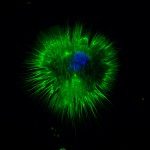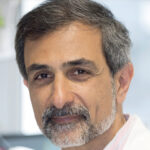Link to Pubmed [PMID] – 29478898
Link to DOI – 10.1016/j.stemcr.2018.01.027
Stem Cell Reports 2018 Mar; 10(3): 956-969
MyoD and Myf5 are fundamental regulators of skeletal muscle lineage determination in the embryo, and their expression is induced in satellite cells following muscle injury. MyoD and Myf5 are also expressed by satellite cell precursors developmentally, although the relative contribution of historical and injury-induced expression to satellite cell function is unknown. We show that satellite cells lacking both MyoD and Myf5 (double knockout [dKO]) are maintained with aging in uninjured muscle. However, injured muscle fails to regenerate and dKO satellite cell progeny accumulate in damaged muscle but do not undergo muscle differentiation. dKO satellite cell progeny continue to express markers of myoblast identity, although their myogenic programming is labile, as demonstrated by dramatic morphological changes and increased propensity for non-myogenic differentiation. These data demonstrate an absolute requirement for either MyoD or Myf5 in muscle regeneration and indicate that their expression after injury stabilizes myogenic identity and confers the capacity for muscle differentiation.


